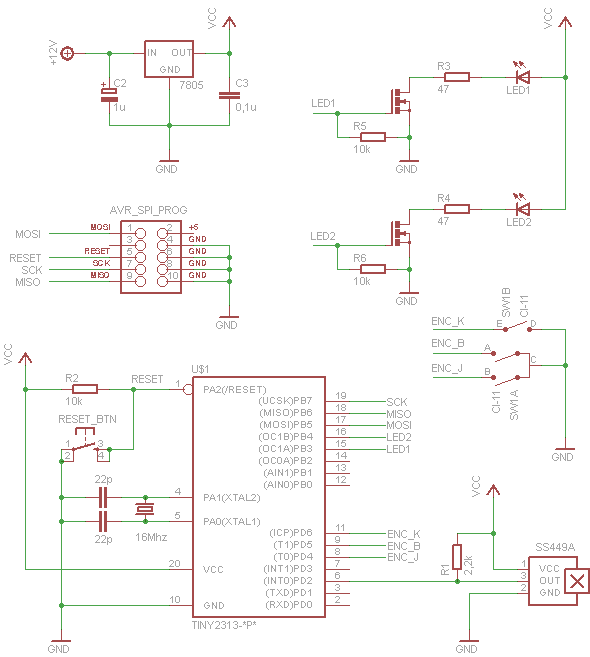[Adam Antok] was compelled to create this repurposed hard drive persistence of vision hack after seeing a toy of the same nature.
 He used the frame, disk and motor from a drive and added LEDs under the spinning disk as the light source. The disk has 8 small holes drilled equidistant around the disk, and spiraling slightly toward the center. As the holes pass by the LEDS they are flashed by the ATtiny2313 processor to create images. To determine the position of the platters a Hall effect sensor is monitored by the 2313 to detect a magnet on the underside of the disk. There is room to display ten characters at one time. Each cursor position can scroll through the character set by rotating an encoder. For all the precision needed to coordinate the LEDs with the spinning holes the electronics and software code are amazingly simple. That’s a really nice job, [Adam]!
He used the frame, disk and motor from a drive and added LEDs under the spinning disk as the light source. The disk has 8 small holes drilled equidistant around the disk, and spiraling slightly toward the center. As the holes pass by the LEDS they are flashed by the ATtiny2313 processor to create images. To determine the position of the platters a Hall effect sensor is monitored by the 2313 to detect a magnet on the underside of the disk. There is room to display ten characters at one time. Each cursor position can scroll through the character set by rotating an encoder. For all the precision needed to coordinate the LEDs with the spinning holes the electronics and software code are amazingly simple. That’s a really nice job, [Adam]!
Persistence of vision hacks are to hackers like flames are to moths. One really nice thing about [Adam’s] project is that you can interact with it while it’s running. Check it out after the break.
For a novel take on POV, check out this slow swinging pendulum clock.
















It’s a Nipkow disk as it was used in the first mechanical televisions: https://en.wikipedia.org/wiki/Nipkow_disk
I was just thinking of turning this into a retro TV. My thought was to use a single vertical row of LEDs and have each one fire as each hole goes by. Alternatively, you could have the drill holes also be in a vertical line, and since the hdd motor is going way faster than a standard nipkow disc, you could do a full frame with each rotation. Depending on how fast you spin the disk you could probably fit up to 6 complete sets of holes that would allow you to get much more frames per rotation than good old NBTV would normally allow.
From a hardware point of view, it’s even easier from this hack, just replace the single colour LED with an RGB one and you’re done.
Okay, the vertical resolution isn’t great as it’s only 8 lines but if you try and add more then you either have to add more elaborate boxing to stop light spill if you go for a second simultaneous scan line or a smaller scan-arc as you fit in all the drill holes to one rotation.
Also japanese researcher made it into a 3D display by using an XY array of leds instead of a single RGB behind the disk..
https://www.youtube.com/watch?v=KW9Es2cD0LI
Be sure to note that a square punched hole will give better S/N than a round drilled one. Go NBTVA
Wow!
Thanks for the info/link. I didn’t know this exact design existed before (and had a name).
Sometimes I wish I would have been born in the 19th century :)
By the way, I’ve just corrected the page, most of the code was missing because of some unescaped characters..
If your interested in mechanical television (and you’ve pretty much built one) check out John Logie Baird on Wikipedia, a pioneer in mechanical television.
https://en.wikipedia.org/wiki/John_Logie_Baird
Cool!
But headphone alert!
Not “HELLO WRLD”?
I fear for his data! Everyone knows you must not operate a hard drive with the cover off!
Oh, wait–wrong article.
B^)
This is outrageously amazing